Pioneer HTP-330, SX-SW330, S-ST330 User Manual

HTP-330
SX-SW330
S-ST330
Audio Multi-channel Receiver Subwoofer
Speaker System
Operating Instructions
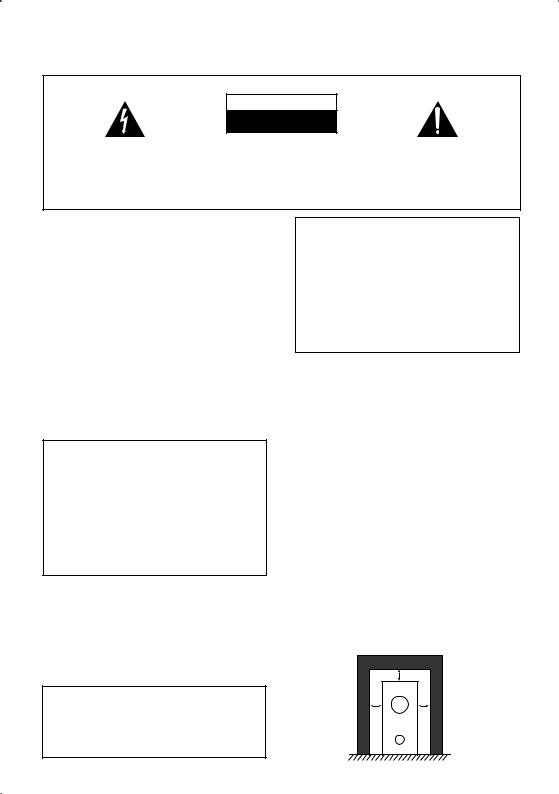
Thank you for buying this Pioneer product.
Please read through these operating instructions so that you will know how to operate your model properly. After you have finished reading the instructions, put them in a safe place for future reference.
IMPORTANT
CAUTION
RISK OF ELECTRIC SHOCK
DO NOT OPEN
The lightning flash with arrowhead symbol, within an equilateral triangle, is intended to alert the user to the presence of uninsulated "dangerous voltage" within the product's enclosure that may be of sufficient magnitude to constitute a risk of electric shock to persons.
CAUTION:
TO PREVENT THE RISK OF ELECTRIC SHOCK, DO NOT REMOVE COVER (OR BACK). NO USER-SERVICEABLE PARTS INSIDE. REFER SERVICING TO QUALIFIED SERVICE PERSONNEL.
The exclamation point within an equilateral triangle is intended to alert the user to the presence of important operating and maintenance (servicing) instructions in the literature accompanying the appliance.
D3-4-2-1-1_En-A
WARNING
This equipment is not waterproof. To prevent a fire or shock hazard, do not place any container filed with liquid near this equipment (such as a vase or flower pot) or expose it to dripping, splashing, rain or moisture.
WARNING
To prevent a fire hazard, do not place any naked flame sources (such as a lighted candle) on the equipment.
Operating Environment
Operating environment temperature and humidity: +5 ºC to +35 ºC (+41 ºF to +95 ºF); less than 85 %RH (cooling vents not blocked)
Do not install this unit in a poorly ventilated area, or in locations exposed to high humidity or direct sunlight (or strong artificial light)
CAUTION
The STANDBY/ON switch on this unit will not completely shut off all power from the AC outlet. Since the power cord serves as the main disconnect device for the unit, you will need to unplug it from the AC outlet to shut down all power. Therefore, make sure the unit has been installed so that the power cord can be easily unplugged from the AC outlet in case of an accident. To avoid fire hazard, the power cord should also be unplugged from the AC outlet when left unused for a long period of time (for example, when on vacation).
WARNING
Before plugging in for the first time, read the following section carefully.
The voltage of the available power supply differs according to country or region. Be sure that the power supply voltage of the area where this unit will be used meets the required voltage (e.g., 230 V or 120 V) written on the rear panel.
This product is for general household purposes. Any failure due to use for other than household purposes (such as long-term use for business purposes in a restaurant or use in a car or ship) and which requires repair will be charged for even during the warranty period.
If the AC plug of this unit does not match the AC outlet you want to use, the plug must be removed and appropriate one fitted. Replacement and mounting of an AC plug on the power supply cord of this unit should be performed only by qualified service personnel. If connected to an AC outlet, the cut-off plug can cause severe electrical shock. Make sure it is properly disposed of after removal.
The equipment should be disconnected by removing the mains plug from the wall socket when left unused for a long period of time (for example, when on vacation).
POWER-CORD CAUTION
Handle the power cord by the plug. Do not pull out the plug by tugging the cord and never touch the power cord when your hands are wet as this could cause a short circuit or electric shock. Do not place the unit, a piece of furniture, etc., on the power cord, or pinch the cord. Never make a knot in the cord or tie it with other cords. The power cords should be routed such that they are not likely to be stepped on. A damaged power cord can cause a fire or give you an electrical shock. Check the power cord once in a while. When you find it damaged, ask your nearest PIONEER authorized service center or your dealer for a replacement.
VENTILATION CAUTION
When installing this unit, make sure to leave space around the unit for ventilation to improve heat radiation (at least 5 cm at top, 5 cm at rear, and 5 cm at each side).
WARNING
Slots and openings in the cabinet are provided for ventilation to ensure reliable operation of the product, and to protect it from overheating. To prevent fire hazard, the openings should never be blocked or covered with items (such as newspapers, table-cloths, curtains) or by operating the equipment on thick carpet or a bed.
|
5 cm |
5 cm |
5 cm |

Contents
Contents
01 Speaker Setup Guide
Safety precautions when setting up . . . . . . . . . . . . . . . 4
Home theater sound setup . . . . . . . . . . . . . . . . . . . . . 4
Front surround setup (recommended). . . . . . . . . . . . 4
Standard surround setup . . . . . . . . . . . . . . . . . . . . . 6
Wall mounting the speakers . . . . . . . . . . . . . . . . . . . . 7
Before mounting . . . . . . . . . . . . . . . . . . . . . . . . . . . . 7
Additional notes on speaker placement . . . . . . . . . . . . 7
02 Connecting up
Basic connections . . . . . . . . . . . . . . . . . . . . . . . . . . . . 8
Using this system for TV audio. . . . . . . . . . . . . . . . . . 11
03 Controls and displays
Display unit . . . . . . . . . . . . . . . . . . . . . . . . . . . . . . . . 12 Display . . . . . . . . . . . . . . . . . . . . . . . . . . . . . . . . . . 12 Remote control . . . . . . . . . . . . . . . . . . . . . . . . . . . . . 13 Using the remote control . . . . . . . . . . . . . . . . . . . . . . 14
Putting the batteries in the remote control . . . . . . . . 14
04 Getting started
System demo setting . . . . . . . . . . . . . . . . . . . . . . . . . 15
Using the Auto MCACC setup for optimal surround sound . . . . . . . . . . . . . . . . . . . . . . . . . . . . . . . . . . . . 15
05 Listening to your system
Auto listening mode . . . . . . . . . . . . . . . . . . . . . . . . . 16
Listening in surround sound . . . . . . . . . . . . . . . . . . . 16 Dolby Pro Logic II Music settings . . . . . . . . . . . . . . 16 Using Front Stage Surround Advance . . . . . . . . . . . . 17
Using Advanced Surround. . . . . . . . . . . . . . . . . . . . . 17 Listening in stereo . . . . . . . . . . . . . . . . . . . . . . . . . . . 17 Using the Sound Retriever . . . . . . . . . . . . . . . . . . . . . 17
Listening with Acoustic Calibration EQ . . . . . . . . . . . 18
Enhancing dialogue. . . . . . . . . . . . . . . . . . . . . . . . . . 18
Using Quiet and Midnight listening modes . . . . . . . . 18 Adjusting the bass and treble . . . . . . . . . . . . . . . . . . 18
Boosting the bass level . . . . . . . . . . . . . . . . . . . . . . . 18
06 Listening to the radio
Listening to the radio . . . . . . . . . . . . . . . . . . . . . . . . . 19
Improving poor FM reception . . . . . . . . . . . . . . . . . 19
Improving poor AM sound. . . . . . . . . . . . . . . . . . . . 19 Memorizing stations . . . . . . . . . . . . . . . . . . . . . . . . 19
Listening to station presets . . . . . . . . . . . . . . . . . . . 19 Changing the frequency step . . . . . . . . . . . . . . . . . 20
07 Surround sound settings
Using the Setup menu. . . . . . . . . . . . . . . . . . . . . . . . 21 Channel level setting . . . . . . . . . . . . . . . . . . . . . . . . 21 Speaker distance setting . . . . . . . . . . . . . . . . . . . . . 21 Dynamic Range Control . . . . . . . . . . . . . . . . . . . . . 21 Dual mono setting. . . . . . . . . . . . . . . . . . . . . . . . . . 22
Adjusting the channel levels using the test tone . . . . 22
08 Other connections
Connecting auxiliary components . . . . . . . . . . . . . . . 23 Connecting an analog audio component. . . . . . . . . 23 Listening to an external audio source . . . . . . . . . . . . 23 Connecting external antennas . . . . . . . . . . . . . . . . . . 23 Using this unit with a Pioneer plasma display . . . . . . 24 SR+ Setup for Pioneer plasma displays . . . . . . . . . 24
Using the SR+ mode with a Pioneer plasma
display. . . . . . . . . . . . . . . . . . . . . . . . . . . . . . . . . . . 25
About control out connections . . . . . . . . . . . . . . . . . 25
09 Additional information
Setting the sleep timer. . . . . . . . . . . . . . . . . . . . . . . . 26 Dimming the display . . . . . . . . . . . . . . . . . . . . . . . . . 26 DTS CD setting . . . . . . . . . . . . . . . . . . . . . . . . . . . . . 26 Resetting the system . . . . . . . . . . . . . . . . . . . . . . . . . 26
Installation and maintenance . . . . . . . . . . . . . . . . . . 27
Hints on installation . . . . . . . . . . . . . . . . . . . . . . . . 27
Setting up the remote to control your TV . . . . . . . . . . 27 Using the TV remote control buttons . . . . . . . . . . . . 27
Preset code list . . . . . . . . . . . . . . . . . . . . . . . . . . . . 28 Troubleshooting. . . . . . . . . . . . . . . . . . . . . . . . . . . . . 29 General . . . . . . . . . . . . . . . . . . . . . . . . . . . . . . . . . . 29 Tuner. . . . . . . . . . . . . . . . . . . . . . . . . . . . . . . . . . . . 30 Error Messages . . . . . . . . . . . . . . . . . . . . . . . . . . . . 30 Glossary. . . . . . . . . . . . . . . . . . . . . . . . . . . . . . . . . . . 30 Specifications . . . . . . . . . . . . . . . . . . . . . . . . . . . . . . 31
English
What’s in the box
Please confirm that the following items are all supplied.
Receiver subwoofer (SX-SW330) box:
•Remote control (page 13)
•AA/R6 dry cell batteries (to confirm operation) x2 (page 14)
•Display unit (page 12)
•Power cords x2 (page 11)
•AM loop antenna (page 9)
•FM wire antenna (page 9)
•Display cable (page 9)
•Coaxial cable (page 23)
•Microphone (for Auto MCACC setup) (page 15)
• Non-skid pads (large) x4 (page 5, 6)
• Spacers x2 (page 9)
• This operating instructions
Speakers (S-ST330) box:
• Speakers (front x2, surround x2, center x2) (page 9)
• Speaker cables x5 (page 9)
• Non-skid pads (small) x24 (page 5, 6)
• Brackets x2 (page 5, 6)
• Spiral wrap x2 (page 10)
• Screws x8 (page 5, 6)
3
En
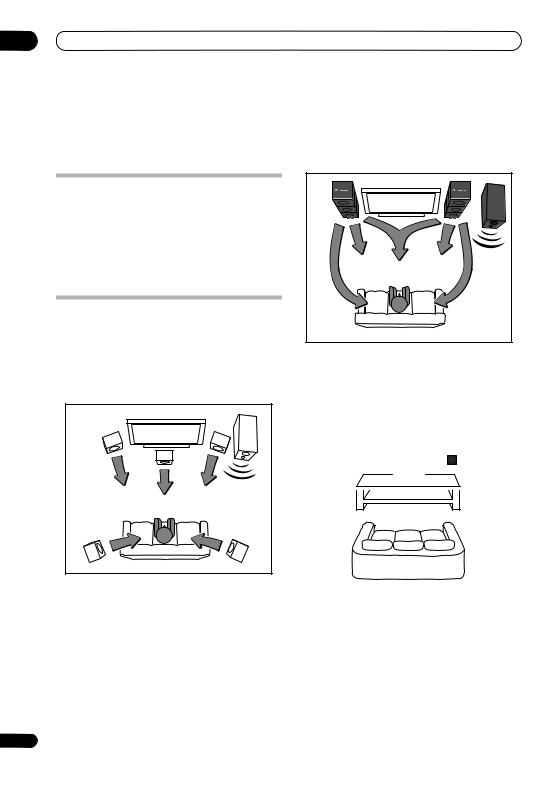
01 Speaker Setup Guide
Chapter 1
Speaker Setup Guide
Safety precautions when setting up
When assembling the speakers, lay them down flat on their side to avoid accidents or injury. Make sure to use a stable surface when assembling, setting up, and placing the speakers.
If the speakers are to be used in a stacked configuration, always use the provided brackets to secure them together (page 5, 6).
Home theater sound setup
Most 5.1 channel home theater systems are designed so that speakers are placed to surround the listener’s position as shown in the illustration. Such designs, however, produce the undesirable effect of forcing the center speaker to be mounted above or below the television monitor, and require room for the surround speakers.
Front left |
Bass |
Front right |
|
|
Center |
Surround left |
Surround right |
|
The present system, however, features Pioneer’s proprietary New Front Surround technology and Dual Center Speakers, using only two speaker positions (to right and left of television as shown in the illustration) in order to provide full home theater sound while greatly simplifying the issue of speaker placement.
|
Bass |
Front left |
Front right |
|
Center |
Surround left |
Surround right |
Front surround setup (recommended)
This recommended method places the surround speakers in front, to simplify the issue of speaker placement in the room. The center speakers can be placed in independently in the center if desired.
Surround |
Surround |
left |
right |
Center |
Center |
Front |
Front |
left |
right |
Receiver subwoofer
Listening position
*When center speakers are placed in the center.
Surround |
Surround |
left |
right |
Front |
Front |
left |
right |
|
Center |
4
En

Speaker Setup Guide |
01 |
1 Attach the smaller non-skid pads to the base of |
As shown in the illustration, stack the speakers from the |
each of the front, center and surround speakers. The |
bottom up in the order front speaker, center speaker, |
four large non-skid pads are for the receiver |
surround speaker. Align the bracket with the respective |
subwoofer (as shown). |
upper screw hole on the back of the front speaker, the |
Use the adhesive side of the pads to attach them to the |
two screw holes on the center speaker, and the bottom |
base (flat surface) of each speaker. |
screw hole on the surround speaker, and fasten the |
|
screws securely. |
Bracket
|
|
Surround speaker |
Non-skid pads |
|
Center speaker |
(small) x 24 |
Front, Center and Surround speakers |
|
|
|
|
|
|
Screw |
|
|
Front speaker |
Non-skid pads (large) x 4
Receiver subwoofer
2 Stack the speakers and fix with the brackets.
Each speaker is provided with a color-coded indicator on the model label on the rear side to assist identification. Refer to the color indicators and install the speakers correctly.
|
Left |
|
Right |
Model label |
Blue |
Surround speaker |
Gray |
|
|
|
|
|
|
|
|
|
Green |
Center speaker |
Green |
|
|
|
|
Color indicator |
White |
Front speaker |
Red |
|
|
|
|
When placing the center speakers independently, stack the front speaker on the bottom and the surround speaker on top, then align the 1st and 3rd screw holes from the top of the bracket with the upper screw holes on the back of the speakers, and fasten the two securely.
Bracket
Surround speaker
Front speaker |
Screw |
|
 Caution
Caution
•Do not attempt to carry the speakers when they are connected with the bracket. Doing so may cause damage to the bracket or worsen damage to the bracket and speakers in the event they are dropped.
3 Connect the speaker system.
Refer to Connecting up to connect the speakers properly. After connecting everything, place the speakers as shown in the diagram above for optimal surround sound. After placing the speakers, run the Auto MCACC setup (page 15) to complete your surround sound setup.
English
5
En
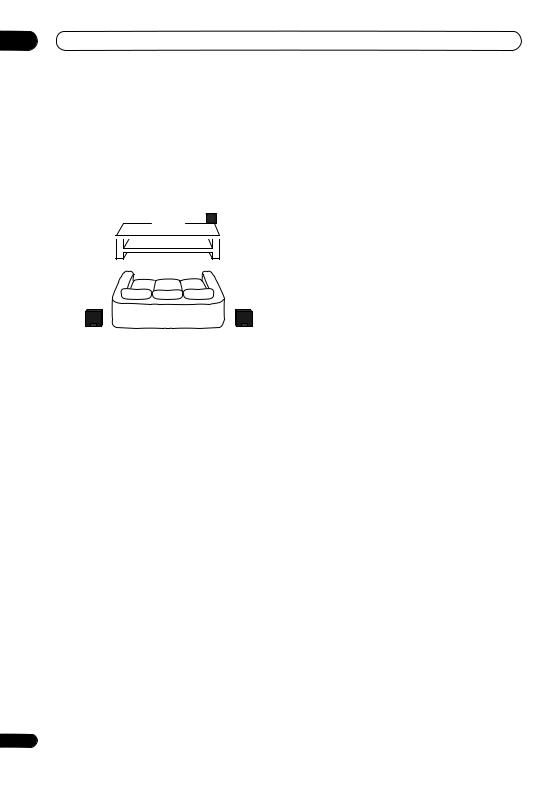
01 Speaker Setup Guide
Standard surround setup
This is a standard multichannel surround sound speaker setup for optimal 5.1 channel home theater sound.
The center speakers can be installed independently in the center if desired.
Center |
Center |
Front |
Front |
left |
right |
Receiver subwoofer
Listening position
Surround left |
Surround right |
*When center speakers are placed in the center.
Front |
Front |
left |
right |
Center |
1 Attach the smaller non-skid pads to the base of each of the front, center and surround speakers. The four large non-skid pads are for the receiver subwoofer (as shown).
Use the adhesive side of the pads to attach them to the base (flat surface) of each speaker.
Non-skid pads |
|
(small) x 24 |
Front, Center and Surround speakers |
|
Non-skid pads (large) x 4
Receiver subwoofer
6
2 (When mounting center speakers to right and left) Stack the speakers and fix with the bracket.
Each speaker is provided with a color-coded indicator on the model label on the rear side to assist identification. Refer to the color indicators and install the speakers correctly.
Model label |
Left |
|
Right |
|
|
|
|
|
Green |
Center speaker |
Green |
|
White |
Front speaker |
Red |
|
Color indicator |
|
|
As shown in the illustration, stack the speakers with the front speaker on the bottom and center speaker on top, then align the 1st and 3rd screw holes from the top of the bracket with the upper screw holes on the back of the speakers, and fasten the two securely.
Bracket
Center speaker
Front speaker |
Screw |
|
 Caution
Caution
•Do not attempt to carry the speakers when they are connected with the bracket. Doing so may cause damage to the bracket or worsen damage to the bracket and speakers in the event they are dropped.
3 Connect the speaker system.
Refer to Connecting up to connect the speakers properly. After connecting everything, place the speakers as shown in the diagram above for optimal surround sound. After placing the speakers, run the Auto MCACC setup (page 15) to complete your surround sound setup.
En
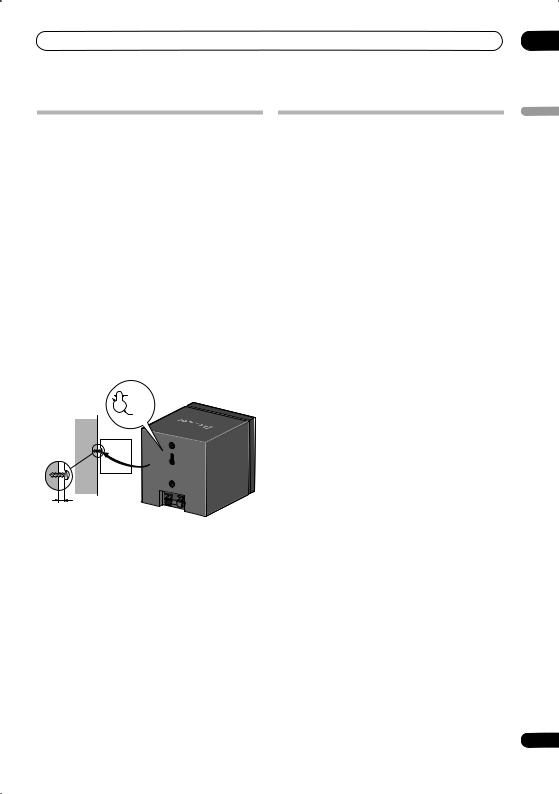
Speaker Setup Guide
Wall mounting the speakers
The front, center and surround speakers have a mounting hole which can be used to mount the speaker on the wall.
Before mounting
•Remember that the speaker system is heavy and that its weight could cause the screws to work loose, or the wall material to fail to support it, resulting in the speaker falling. Make sure that the wall you intend to mount the speakers on is strong enough to support them. Do not mount on plywood or soft surface walls.
•Mounting screws are not supplied. Use screws suitable for the wall material and support the weight of the speaker.
 Caution
Caution
•If you are unsure of the qualities and strength of the wall, consult a professional for advice.
•Pioneer is not responsible for any accidents or damage that result from improper installation.
5 mm
10 mm
5 mm to 7 mm
Additional notes on speaker placement
•Install the main front left and right speakers at an equal distance from the TV.
•When using the Front surround setup, separate the left and right speakers by about 1.5 m for optimum effect.
•When using the Standard surround setup, install the surround speakers slightly above ear level for optimum effect.
Precautions:
•When installing the center speaker on top of the TV, be sure to secure it with tape or some other suitable means. Otherwise, the speaker may fall from the TV due to external shocks such as earthquakes, endangering those nearby or damaging the speaker.
•The front (x2), center (x2) and surround (x2) speakers supplied with this system are magnetically shielded. However, depending on the installation location, color distortion may occur if the speaker is installed extremely close to the screen of a television set. If this happens, turn the power switch of the television set OFF, and turn it ON after 15 min to 30 min. If the problem persists, place the speaker system away from the television set.
•The receiver subwoofer is not magnetically shielded and so should not be placed near a TV or monitor. Magnetic storage media (such as floppy discs and tape or video cassettes) should also not be kept close to the receiver subwoofer.
•Do not attach the receiver subwoofer to the wall or ceiling. They may fall off and cause injury.
•For safety, make sure that there is no exposed bare speaker wire outside of the speaker terminals.
•Do not connect the supplied speakers with any other amplifier. This may result in malfunction or fire.
•Do not connect any speakers other than those supplied to this system.
01
English
7
En

02 Connecting up
Chapter 2
Connecting up
Basic connections
 Important
Important
•When connecting this system or changing connections, be sure to switch power off and disconnect the power cord from the wall socket.
After completing all connections, connect the power cord to the wall socket.
Receiver subwoofer
|
|
|
|
ANTENNA |
|
|
|
|
|
|
|
FM UNBAL 75 |
AM LOOP ANTENNA |
||
|
MCACC |
|
|
|
AUDIO INPUT |
|
|
|
SETUP MIC |
CONTROL IN |
|
|
|||
|
|
|
|
|
DIGITAL |
|
|
SYSTEM CONNECTOR CONTROL |
|
SPEAKERS |
|
DVD/DVR1 |
DVD/DVR2 |
DIGITAL |
ANALOG |
OUT |
SUBWOOFER |
R SURROUND L |
(COAXIAL) |
(OPTICAL) |
(OPTICAL) |
|
|
|
|
|
|
|
|
|
L |
USE ONLY WITH DISPLAY UNIT. |
|
|
|
|
|
|
R |
|
|
|
|
|
|
|
|
SEE INSTRUCTION MANUAL. |
|
|
|
|
|
|
|
|
CENTER |
R FRONT |
L |
|
|
|
|
AC IN
 Note
Note
 FM antenna
FM antenna
2 AM loop antenna
3
Display unit
1
Display cable
 WARNING
WARNING
•When using the display unit in a wall-mounted location, take full precautions to prevent the unit from accidentally falling.
•Screws and other fixtures for use in wall mounting are not included.
•Pioneer bears no responsibility for accidents resulting from faulty assembly or installation, insufficient mounting strength of walls, mounting fixtures (or other building fixtures), misuse or natural disasters.
8
En
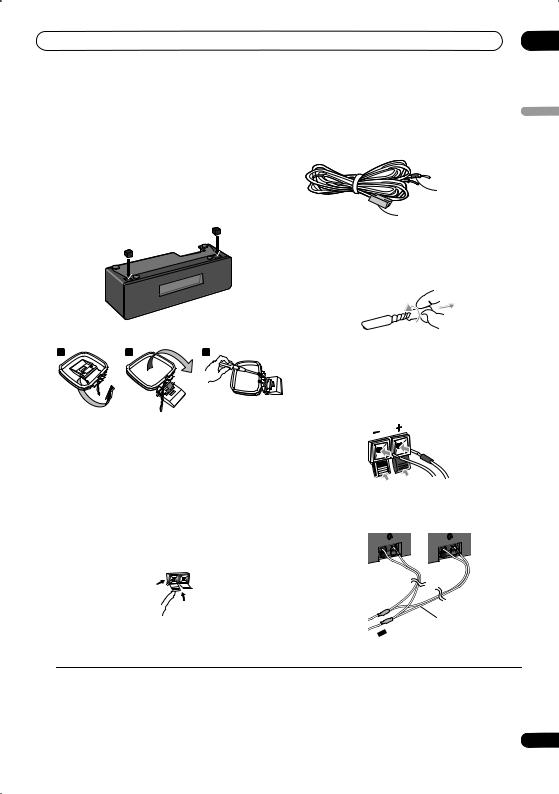
Connecting up |
02 |
1 Fasten the spacers to the display unit and connect.
If the display unit is difficult to view, the spacers can be attached to allow changing of the viewing angle. Peel off the protective paper from the spacers and press the spacers onto the depressions on the bottom of the display unit.
Plug the L-shaped end of the display cable into the connector on the rear of the display unit, then plug the other end of the display cable into SYSTEM CONNECTOR jack on the receiver subwoofer.
2 Assemble the AM loop antenna.
a |
b |
c |
4Connect each speaker.
•The front and surround speaker cables have a colorcoded connector at one end and two bare wires at the other end.
Color-coded wire (Connect to speaker)
Color-coded connector (Connect to rear panel)
•Since there is only one terminal to connect the two center speakers, you will need to use the supplied Y- cable for the connection.
•Twist and pull off the protective shields on each wire.
•Connect the wires to the speaker. Each speaker in the illustration can be identified by means of the colorcoded indicator provided on the rear-surface model label. Match the color-coded wire with the color indicator on the model label, then insert the colorcoded wire into the red (+) side and the other wire into the black (–) side.
English
a.Bend the stand in the direction indicated by the arrow.
b.Clip the loop onto the stand.
c.If you want to fix to a wall or other surface, perform step b after first securing the stand with screws.
It is recommended that you determine the reception strength before securing the stand with the screws.
3Connect the AM and FM antennas1.
a.Connect one wire of the AM loop antenna to each AM antenna terminal2.
For each terminal, press down on the tab to open; insert the wire, then release to secure.
1


 2
2
b.Push the FM antenna3 plug onto the center pin of the FM antenna socket.
•When connecting the center speakers, connect the Y- cable dual end to the two center speakers in the same way.
Y-cable

 To Receiver subwoofer
To Receiver subwoofer
 Note
Note
1 • Keep antenna cables away from other cables, the display unit and receiver subwoofer.
•If reception with the supplied antenna is poor, see Improving poor FM reception and Improving poor AM sound on page 19 or Connecting external antennas on page 23.
•Do not attach any antenna other than the provided loop antenna, or an external antenna as described on page 23.
2 • Don’t let it come into contact with metal objects and avoid placing near computers, television sets or other electrical appliances.
•If radio reception is poor, you may be able improve it by re-inserting each antenna wire into the opposite terminal.
•For best reception, do not untwist the AM loop antenna wires or wrap them around the loop antenna.
3 To ensure optimum reception, make sure the FM antenna is fully extended and not coiled or hanging at the rear of the unit.
9
En
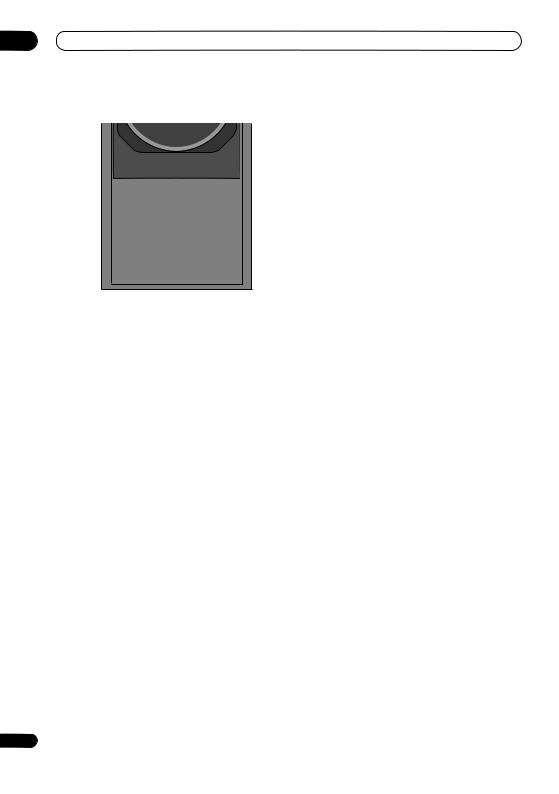
02 Connecting up
Receiver subwoofer |
|
|
|
|
|
|
|
|
||
|
|
|
|
|
|
|
|
Surround right |
|
Surround left |
|
|
|
|
|
|
|
|
(Gray) |
|
(Blue) |
5 |
|
|
|
ANTENNA |
|
|
|
|
|
|
|
|
|
|
FM UNBAL 75 |
AM LOOP ANTENNA |
|
|
|
||
|
MCACC |
|
|
|
AUDIO INPUT |
|
|
|
|
|
|
SETUP MIC |
CONTROL IN |
|
|
|
|
|
|||
|
|
|
|
|
DIGITAL |
|
|
|
|
|
SYSTEM CONNECTOR CONTROL |
SPEAKERS |
L |
DVD/DVR1 |
DVD/DVR2 |
DIGITAL |
ANALOG |
|
|
|
|
OUT |
SUBWOOFER |
R SURROUND |
(COAXIAL) |
(OPTICAL) |
(OPTICAL) |
|
Center |
|
Center |
|
|
|
|
|
4 |
|
L |
Listening position |
|||
|
|
|
|
|
|
(Green) |
(Green) |
|||
|
|
|
|
|
R |
|
||||
USE ONLY WITH DISPLAY UNIT. |
|
|
|
|
|
|
|
|
||
SEE INSTRUCTION MANUAL. |
|
|
|
|
|
|
|
|
||
|
CENTER |
R FRONT |
L |
|
|
|
|
|
Y-cable |
|
|
|
|
|
|
|
|
|
|
|
|
AC IN |
|
|
|
|
|
|
|
|
|
|
|
|
|
|
|
|
|
|
Front right |
|
Front left |
|
|
|
|
|
|
|
|
(Red) |
|
(White) |
7 |
Speaker system |
|
To AC outlet |
•Connect the other end to the color-coded speaker terminals on the rear of the receiver subwoofer. Make sure to insert completely.
The small lug at the wire-end of the speaker plug should face up or down depending on whether it’s being plugged into one of the upper or lower speaker terminals. Please make sure to connect correctly.
•Fasten the cables together with the spiral wrap. Hold multiple cables together and place the wrap over the cables from the end.
Wrap the spiral wrap with the cables in the center. The spiral wrap may be cut at a desired length.
Upper terminal |
Lower terminal |
•When connections are completed, adjust the cable placements. If the speakers have been fixed with the brackets, fix the cable to the groove in the brackets as shown.
5Connect the subwoofer cable.
•Just below the subwoofer speaker, to the left of center, you should see the subwoofer connecting cable. Plug this into the SUBWOOFER SPEAKER terminal.
 Caution
Caution
•These speaker terminals carry HAZARDOUS LIVE voltage. To prevent the risk of electric shock when connecting or disconnecting the speaker cables, disconnect the power cord before touching any uninsulated parts.
•Do not connect any speakers other than those supplied to this system.
10
En
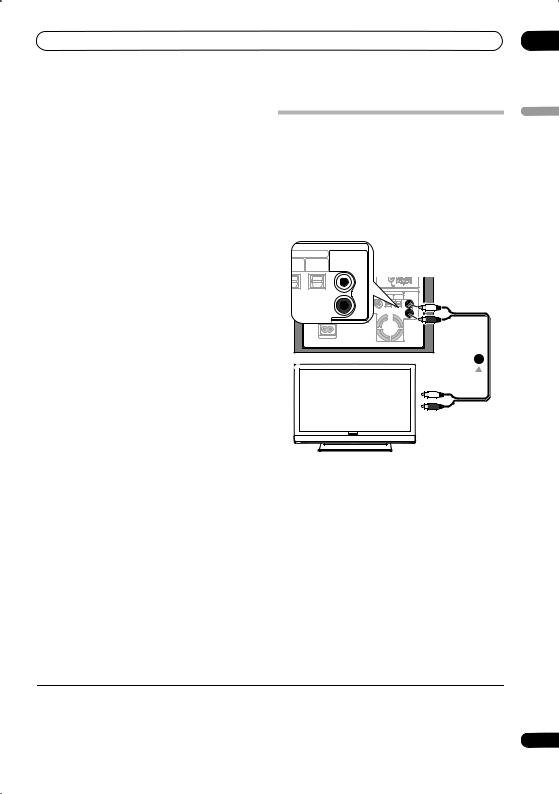
Connecting up
•Do not connect the supplied speakers to any amplifier other than the one supplied with this system. Connection to any other amplifier may result in malfunction or fire.
•The center speakers and front/surround speakers are designed with different impedance values. Be sure to identify and connect the speakers correctly since improper connections may result in degraded sound or operation.
6If you have a DVD player or other source1 component you want to connect, connect it now before connecting the power cord in the next step.
See Connecting auxiliary components on page 23 for how to connect a digital source component.
7Connect the power cord.2
•Connect the power cord to AC inlet on the receiver subwoofer. Connect the power cord to a wall socket.
Using this system for TV audio
If your TV has a stereo audio output you can connect it to this system and enjoy surround TV sound.
 Important
Important
•When connecting this system, be sure to switch power off and disconnect the power cord from the wall socket. Connect the power cord to the wall socket only after completing all other connections.
AUDIO INPUT
ITAL
VR 2 |
DIGITAL |
ANALOG |
TICAL) |
(OPTICAL) |
|
L
|
FM UNBAL 75 |
AM LOOP ANTENNA |
CONTROL IN |
AUDIO INPUT |
|
|
DIGITAL |
|
SYSTEM CONNECTOR |
CONTROL |
|
L |
DVD/DVR1 |
DVD/DVR2 |
DIGITAL |
ANALOG |
|
OUT |
SURROUND |
(COAXIAL) |
(OPTICAL) |
(OPTICAL) |
|
|
|
|
R |
|
|
|
L |
|
USE ONLY WITH DISPLAY UNIT |
|
|
|
|
|
R |
|
SEE INSTRUCTION MANUAL. |
|
|
|
|
|
|
|
CENTER R FRONT L
AC IN |
1
To Audio output
TV
1 Connect the audio output jacks on your TV to the ANALOG input jacks on the receiver subwoofer.
Use the red/white stereo audio cable (not supplied) for this connection. Make sure you match the left and right outputs with their corresponding inputs for correct stereo sound.
•You can use the ANALOG input jacks for any analog source you want, such as a tape deck, etc.
 Note
Note
1 Make sure to connect a TV or monitor (for video sources) to take advantage of this system’s home theater potential. Please refer to the instruction manual supplied with your TV or monitor for connection details.
2 • Do not use any power cord other than the one supplied with this system.
• Do not use the supplied power cord for any purpose other than connecting to this system.
02
English
11
En
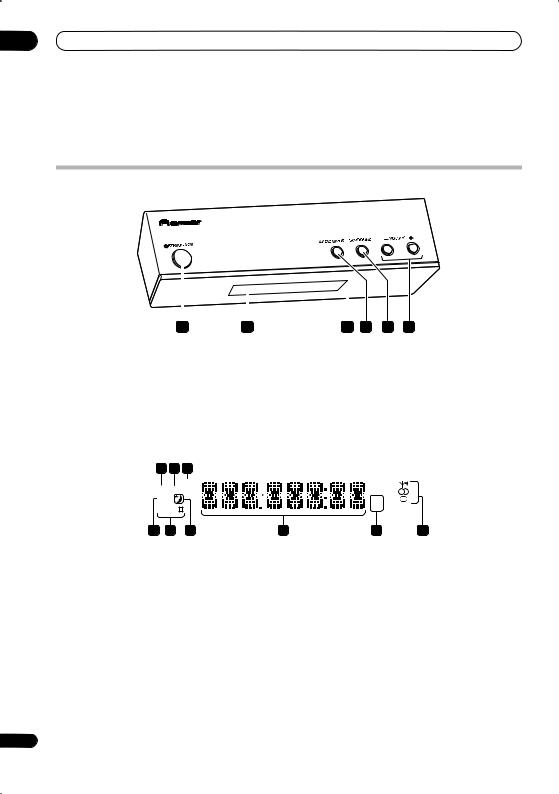
03 Controls and displays
Chapter 3
Controls and displays
Display unit
|
|
|
|
|
|
|
|
|
|
|
|
|
|
|
|
|
|
|
|
|
|
|
|
|
|
|
|
|
|
|
|
|
|
|
|
|
|
|
|
|
1 |
2 |
|
3 |
4 |
5 |
6 |
|
|||
1 |
STANDBY/ON |
|
|
4 |
AUDIO INPUT (page 23) |
|||||||
Press to switch the system on/into standby. |
|
|
Press repeatedly to select one of the external audio |
|||||||||
2 |
Front panel display |
|
|
inputs (DVD/DVR1, DVD/DVR2, DIGITAL or ANALOG). |
||||||||
|
|
|
|
|
|
|
|
|
||||
See below for details. |
|
|
5 |
SURROUND |
|
|
|
|
||||
3 |
IR remote sensor (page 14) |
|
|
Use to select a Surround mode (page 16). |
||||||||
|
|
|
|
|
|
|
|
|
||||
|
|
|
|
|
|
6 |
VOLUME buttons |
|
|
|
||
|
|
|
|
|
|
Use to adjust the volume. |
|
|
||||
Display
1 |
2 |
3 |
|
|
SOUND |
|
|
DTS F.SURR. |
|
||
2D |
|
|
|
2PL |
|
|
|
9 |
8 |
7 |
6 |
1 DTS
Lights during playback of a DTS source (page 16).
2F.SURR.
Lights when one of the Front Stage Surround Advance listening modes is selected (page 17).
SURR.
Lights when one of the Advanced Surround listening modes is selected (page 17).
3SOUND
Lights when Sound Retriever is active (page 17).
4Tuner indicators (page 19)

 – Lights when a broadcast is being received.
– Lights when a broadcast is being received.
 – Lights when a stereo FM broadcast is being received in auto stereo mode.
– Lights when a stereo FM broadcast is being received in auto stereo mode.
12
kHz MHz
5 4
 – Lights when FM mono reception is selected.
– Lights when FM mono reception is selected.
5 kHz / MHz
Indicates the frequency unit shown in the character display (kHz for AM, MHz for FM).
6Character display
7
Lights when sleep timer is active (page 26).
8 2 PL II
Lights during Dolby Pro Logic II decoding (page 16).
9 2 D
Lights during playback of a Dolby Digital source (page 16).
En
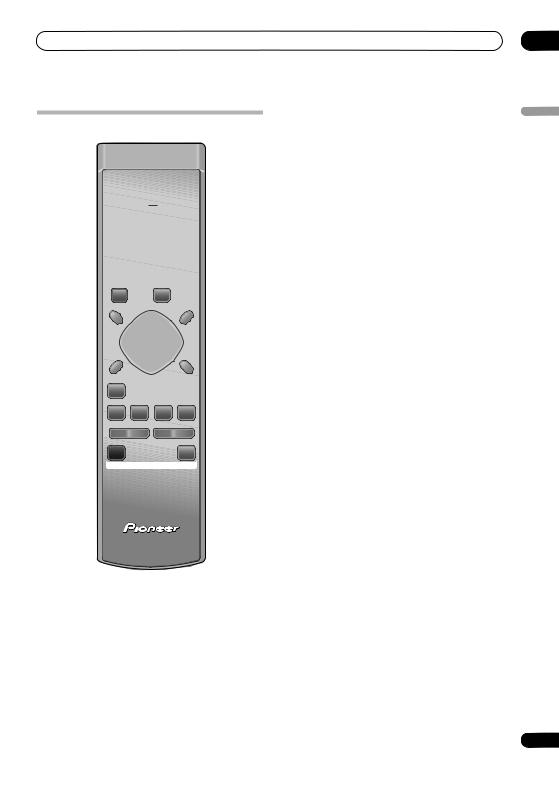
Controls and displays
Remote control
STANDBY/ON
1 |
|
MUTE |
|
|
|
|
|
|
|
||
2 |
|
VOLUME |
|
3 |
|
|
|
|
|
||
4 |
DVD/DVR1 |
DVD/DVR2 |
DIGITAL |
ANALOG |
|
|
|
|
|
|
|
|
|
|
|
FM/AM |
|
5 |
|
|
|
|
|
|
|
|
|
SLEEP |
6 |
|
ENTER |
|
CLEAR |
|
|
7 |
SETUP |
|
|
SR |
8 |
|
TUNE |
|
|
||
|
|
|
|
|
|
9 |
ST |
ST |
|
|
|
|
ENTER |
|
|
||
|
SOUND |
|
|
TEST |
|
10 |
TUNE |
|
TONE |
11 |
|
|
|
|
|||
|
SOUND |
|
|
|
14 |
|
RETRIEVER |
|
|
|
|
12 |
|
|
|
|
15 |
|
SURROUND |
ADVANCED |
F.S.SURR |
MCACC |
|
13 |
|
|
|
|
16 |
|
CHANNEL |
VOLUME |
|
||
17 |
TV |
|
|
INPUT |
|
TV CONTROL
RECEIVER
1 STANDBY/ON
Press to switch the receiver subwoofer on or into standby.
2 MUTE
Press to mute all audio from the speakers. Press again to cancel and restore the sound.
3 VOLUME +/–
Use to adjust the volume.
4Input select buttons
DVD/DVR1 – Press to select the DVD/DVR1 digital audio input.
DVD/DVR2 – Press to select the DVD/DVR2 digital audio input.
DIGITAL – Press to select the DIGITAL audio input.
ANALOG – Press to select the ANALOG audio input. (page 23)
FM/AM – Press to select the built-in radio tuner. (page 19)
5Number buttons, CLEAR and ENTER
Use the number buttons for entering radio stations directly, and so on.
Use CLEAR to clear an entry and start again.
Use ENTER to confirm an entry.
6 SLEEP
Press to set the sleep timer (page 26).
7 SETUP
Use to access the menu system for surround sound setup, tuner settings and so on (page 15, 19, 20, 21, 26).
8 SR+
Use to setup the SR+ features and to select the SR+ mode (page 25).
9/ / / (cursor buttons) and ENTER
Use to navigate the receiver subwoofer menus.
10SOUND (page 18)
Press to access the sound menu, from which you can adjust bass and treble, etc.
11 TEST TONE
Use to output the test tone (for speaker setup) (page 22).
12 SOUND RETRIEVER
Press to restore CD quality sound to compressed stereo audio sources (page 17).
13 SURROUND
Use to select a Surround mode (page 16).
14 ADVANCED
Use to select a Pioneer original surround mode (page 17).
15 F.S.SURR
Use to select a Front Stage Surround Advance mode (page 17).
16 MCACC
Starts the Auto MCACC setup (page 15).
17 TV CONTROL (page 27)
After setting up, use these controls to control your TV.
03
English
13
En
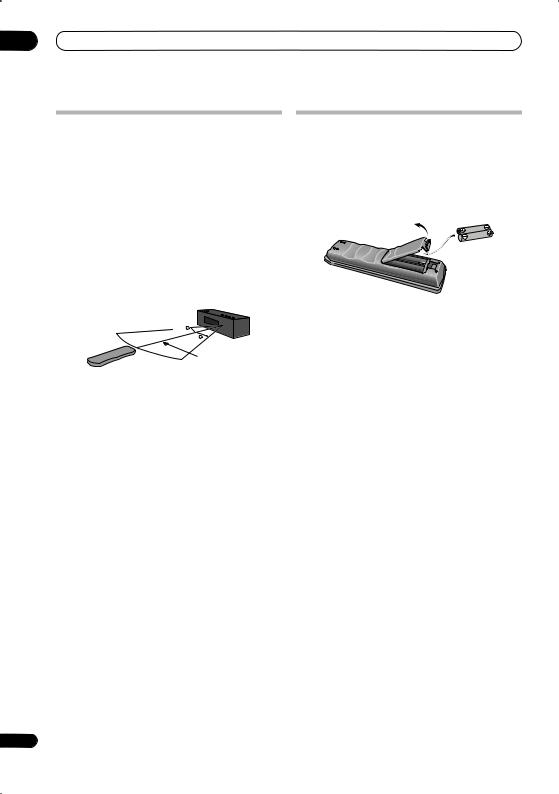
03 Controls and displays
Using the remote control
Please keep in mind the following when using the remote control:
•Make sure that there are no obstacles between the remote and the remote sensor on the unit.
•Remote operation may become unreliable if strong sunlight or fluorescent light is shining on the unit’s remote sensor.
•Remote controllers for different devices can interfere with each other. Avoid using remotes for other equipment located close to this unit.
•Replace the batteries when you notice a fall off in the operating range of the remote.
•Use within the operating range in front of the remote control sensor on the display unit, as shown.
30 

30
7 m
14
Putting the batteries in the remote control
1Open the battery compartment cover on the back of the remote control.
2Insert two AA/R6 batteries into the battery compartment following the indications ( , ) inside the compartment.
3 Close the cover.
 Caution
Caution
Incorrect use of batteries can result in hazards such as leakage and bursting. Please observe the following:
•Don’t mix new and old batteries together.
•Don’t use different kinds of battery together — although they may look similar, different batteries may have different voltages.
•Make sure that the plus and minus ends of each battery match the indications in the battery compartment.
•Remove batteries from equipment that isn’t going to be used for a month or more.
•When disposing of used batteries, please comply with governmental regulations or environmental public instruction’s rules that apply in your country or area.
 WARNING
WARNING
•Do not use or store batteries in direct sunlight or other excessively hot place, such as inside a car or near a heater. This can cause batteries to leak, overheat, explode or catch fire. It can also reduce the life or performance of batteries.
En

Getting started
Chapter 4
Getting started
System demo setting
Switches the automatic demo feature on or off (this starts when you plug in for the first time).
|
SLEEP |
ENTER |
CLEAR |
SETUP |
SR |
|
TUNE |
ST |
ST |
|
ENTER |
SOUND |
TEST |
TONE |
|
|
TUNE |
SOUND
1Switch the system into standby.
2Press SETUP.
3Use the / (cursor left/right) buttons to select
DEMO from the menu, then press ENTER.
4Use the / (cursor up/down) buttons to select a setting, then press ENTER.
Select from:
•DEMO ON – Switches the demo display on.
•DEMO OFF – Switches the demo display off and the system into standby.
Using the Auto MCACC setup for optimal surround sound
The Multichannel Acoustic Calibration (MCACC) system measures the acoustic characteristics of your listening area, taking into account ambient noise, and testing for channel delay and channel level. After you have set up the microphone provided, the system uses the information from a series of test tones to optimize the speaker settings and equalization (Acoustic Calibration
EQ) for your particular room.1
 Important
Important
•The test tones used for Auto MCACC setup are loud; however, do not turn the volume down during setup as this may result in a sub-optimal setup.
•Make sure the microphone and speakers are not moved during the MCACC setup.
SOUND
RETRIEVER
|
SURROUND ADVANCED |
F.S.SURR |
MCACC |
STANDBY/ON |
|
|
|
MUTE |
|
|
|
VOLUME |
CHANNEL |
VOLUME |
|
DVD/DVR1 DVD/DVR2 DIGITAL ANALOG |
TV |
|
INPUT |
1 Connect the microphone to the MCACC SETUP MIC jack on the rear panel.
MCACC
SETUP MIC
|
|
ANTENNA |
|
|
|
FM UNBAL 75 |
AM LOOP ANTENNA |
MCACC |
|
AUDIO INPUT |
|
SETUP MIC |
CONTROL IN |
||
|
|
DIGITAL |
|
SYSTEM CONNECTOR CONTROL |
|
SPEAKERS |
L |
DVD/DVR1 |
DVD/DVR2 |
DIGITAL |
ANALOG |
OUT |
SUBWOOFER |
R SURROUND |
(COAXIAL) |
(OPTICAL) |
(OPTICAL) |
|
|
|
|
|
|
|
|
|
L |
USE ONLY WITH DISPLAY UNIT. |
|
|
|
|
|
|
R |
SEE INSTRUCTION MANUAL. |
|
|
|
|
|
|
|
|
CENTER |
R FRONT |
L |
|
|
|
|
AC IN
2 Place the microphone at your normal listening position.
Place the mic horizontally about ear level at your normal listening position using a table or chair.
Make sure there are no obstacles between the speakers and the microphone.
3If the receiver subwoofer is off, press STANDBY/
ON to turn the power on.
4Press MCACC.
Try to be as quiet as possible after pressing MCACC. The volume increases automatically and the system outputs a series of test tones.
•To cancel Auto MCACC setup before it has finished, press MCACC. The unit will continue to use the previous settings.
•If the ambient noise level is too high, NOISY blinks in the display for five seconds. To exit and check the noise levels2, press MCACC, or to try again, press ENTER when RETRY shows in the display.
•If you see an ERR MIC or ERR SP message in the display, there may be a problem with your mic or the speaker connections. To try again, press ENTER when you see RETRY.3
When the MCACC setup is complete, the volume level returns to normal, COMPLETE4 shows in the display, and Acoustic Calibration EQ is activated.5
 Note
Note
1You only need to use the Auto MCACC setup once (unless you change the placement of your speakers or your room layout).
2• If the room environment is not optimal for the Auto MCACC setup (too much ambient noise, echo off the walls, obstacles blocking the speakers from the microphone) the final settings may be incorrect. Check for household appliances (air conditioner, fridge, fan, etc.), that may be affecting the environment and switch them off if necessary.
• Some older TVs may interfere with the operation of the mic. If this seems to be happening, switch off the TV during Auto MCACC setup.
3If this doesn’t work, press MCACC, turn off the power, and check the problem indicated by the ERR message, then try the Auto MCACC setup again.
4If COMPLETE doesn’t appear, it is likely an error occurred during the setup. Please check all connections and try again.
5 See Listening with Acoustic Calibration EQ on page 18 to switch on/off Acoustic Calibration EQ.
04
English
15
En

05 Listening to your system
Chapter 5
Listening to your system
Auto listening mode
The Auto listening mode is the simplest way to listen to any source as it was mastered: the output from the speakers mirrors the channels in the source material.
If you set up the system for Front surround (page 4), the Front Surround modes will give the best results (see
Using Front Stage Surround Advance on page 17).
SOUND |
|
TONE |
TUNE |
|
|
SOUND |
|
|
RETRIEVER |
|
|
SURROUND ADVANCED |
F.S.SURR |
MCACC |
CHANNEL |
VOLUME |
|
TV |
|
INPUT |
• Press SURROUND to select the AUTO listening mode.
If the source is Dolby Digital or DTS, the front panel 2 D or DTS indicator lights.
•You can also use the SURROUND button on the display unit to change the listening mode.
Listening in surround sound
You can listen to stereo or multichannel sources in surround sound. Surround sound is generated from stereo sources using one of the Dolby Pro Logic decoding modes.
If you set up the system for Front surround (page 4), the Front Surround modes will give the best results (see
Using Front Stage Surround Advance on page 17).
•AUTO – Auto listening mode (see above)
•DOLBY PL (Dolby Pro Logic) – 4.1 channel surround sound for use with any two-channel source
•MOVIE (Dolby Pro Logic II Movie) – 5.1 channel surround sound, especially suited to movie sources, for use with any two-channel source
•MUSIC (Dolby Pro Logic II Music) – 5.1 channel surround sound, especially suited to music sources, for use with any two-channel source; see Dolby Pro Logic II Music settings below
•STEREO – See Listening in stereo on page 17
Dolby Pro Logic II Music settings
When listening in Dolby Pro Logic II Music mode (see above), there are three settings you can adjust: Center Width, Dimension, and Panorama.
ENTER |
CLEAR |
SETUP |
SR |
|
TUNE |
ST |
ST |
|
ENTER |
SOUND |
TEST |
TONE |
|
|
TUNE |
SOUND |
|
RETRIEVER |
|
1With Dolby Pro Logic II Music mode active, press SOUND.
2Use / (cursor left/right) to select C WIDTH,
DIMEN. or PANORAMA then press ENTER.
•C WIDTH (Center Width) – Provides a better blend of the front speakers by spreading the center channel between the front right and left speakers, making it sound wider (higher settings) or narrower (lower settings)
SOUND |
|
TEST |
|
TONE |
|
TUNE |
|
|
SOUND |
|
|
RETRIEVER |
|
|
SURROUND ADVANCED |
F.S.SURR |
MCACC |
CHANNEL |
VOLUME |
|
TV |
|
INPUT |
• Press SURROUND repeatedly to select a listening mode.
•You can also use the SURROUND button on the display unit to change the listening mode.
The choices that appear in the display will vary according to the type of source that’s playing.
If the source is Dolby Digital or DTS, the front panel 2 D or DTS indicator lights.
•DIMEN. (Dimension) – Adjusts the depth of the surround sound balance from front to back, making the sound more distant (minus settings), or more forward (positive settings)
•PANORAMA – Extends the front strereo image to include the surround speakers for a ‘wraparound’ effect.
3 Use / (cursor up/down) to adjust the setting then press ENTER to confirm.
16
En
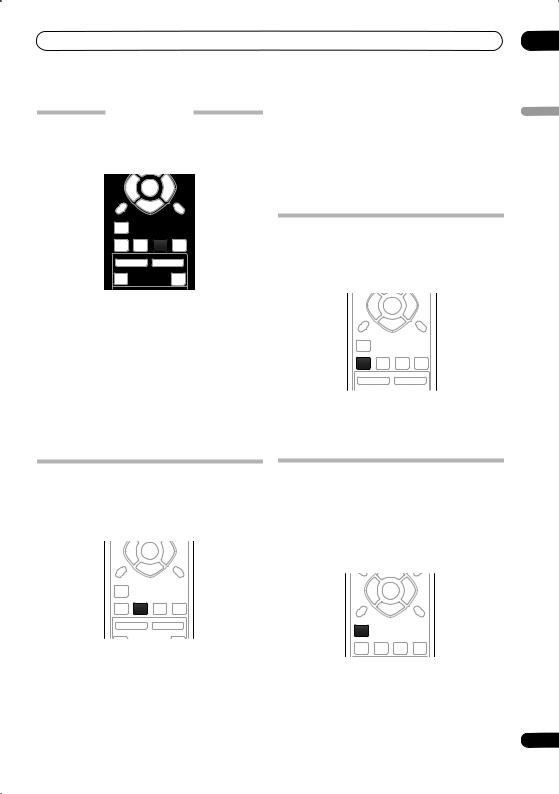
Listening to your system
Using Front Stage Surround Advance
The Front Stage Surround Advance modes are effective when you are using the Front surround speaker setup as described on page 4.
ST |
ST |
|
ENTER |
|
|
SOUND |
|
TEST |
|
TONE |
|
TUNE |
|
|
SOUND |
|
|
RETRIEVER |
|
|
SURROUND ADVANCED |
F.S.SURR |
MCACC |
CHANNEL |
VOLUME |
|
TV |
|
INPUT |
TV CONTROL
• Press F.S.SURR to select a Front Stage Surround Advance mode.
Press repeatedly to select FOCUS5.1, WIDE5.1 or
EXTRAPWR.
•FOCUS5.1 – Use to provide a rich surround sound effect directed to the center area where the left and right speakers’ sound projection converges.
•WIDE5.1 – Use to provide a surround sound effect to a wider area than FOCUS5.1 mode.
•EXTRAPWR – Outputs stereo sound (in the case of multi-channel sources, down-mixed stereo sound) from the surround speakers for powerful stereo effect.
•TV SURR. – Surround sound for mono or stereo TV broadcasts
•SPORTS – Suitable for sports programming
•ADV.GAME – Suitable for TV game units
•VIRTUAL – A virtual surround effect using just the subwoofer and front speakers.
•X-STEREO – Powerful surround sound for stereo music sources
Listening in stereo
You can listen to any source—stereo or multichannel—in stereo. When playing a multichannel source, all channels are downmixed to the front left/right speakers and the subwoofer.
ST |
ST |
|
ENTER |
|
|
SOUND |
|
TEST |
|
TONE |
|
TUNE |
|
|
SOUND |
|
|
RETRIEVER |
|
|
SURROUND ADVANCED |
F.S.SURR |
MCACC |
CHANNEL |
VOLUME |
|
TV |
|
INPUT |
• Press SURROUND repeatedly until STEREO shows in the display.
•You can also use the SURROUND button on the display unit to change the listening mode.
05
English
Using Advanced Surround
The Advanced Surround effects can be used with any multichannel or stereo source for a variety of additional surround sound effects. These modes are designed to provide optimum listening effect when using the Standard surround setup described on page 6.
ST |
ST |
|
ENTER |
|
|
SOUND |
|
TEST |
|
TONE |
|
TUNE |
|
|
SOUND |
|
|
RETRIEVER |
|
|
SURROUND ADVANCED |
F.S.SURR |
MCACC |
CHANNEL |
VOLUME |
|
TV |
|
INPUT |
• Press ADVANCED to select an Advanced Surround mode.
Press repeatedly to select:
•ACTION – Suitable for action movies
•UNPLUGED – Suitable for acoustic musical sources
•EXPANDED – Wide sound field
Using the Sound Retriever
When audio data is removed during the MP3 or WMA compression process, sound quality often suffers from an uneven sound image. The Sound Retriever feature employs new DSP technology that helps bring CD quality sound back to compressed 2-channel audio by restoring sound pressure and smoothing jagged artifacts left over after compression.
|
TUNE |
ST |
ST |
|
ENTER |
SOUND |
TEST |
TONE |
|
|
TUNE |
SOUND |
|
RETRIEVER |
|
SURROUND ADVANCED F.S.SURR MCACC
• While listening to a stereo source, press SOUND RETRIEVER.
Press repeatedly to switch between:
•RTRV ON — Switches the Sound Retriever on.
•RTRV OFF — Switches the Sound Retriever off.
17
En

05 Listening to your system
Listening with Acoustic Calibration EQ
You can listen to sources using the Acoustic Calibration EQ set in Using the Auto MCACC setup for optimal surround sound on page 15.
|
SLEEP |
ENTER |
CLEAR |
SETUP |
SR |
|
TUNE |
ST |
ST |
|
ENTER |
SOUND |
TEST |
TONE |
|
|
TUNE |
SOUND |
|
RETRIEVER |
|
SURROUND ADVANCED F.S.SURR MCACC
1Press SOUND.
2Use the / (cursor left/right) buttons to select
MCACC EQ then press ENTER.
3Use the / (cursor up/down) buttons to switch
EQ ON or EQ OFF then press ENTER to confirm.
•On the EQ OFF setting, equalization is set to off and speaker settings (channel delay and channel level) remains as it is set.
•Acoustic Calibration EQ is set to on automatically after Auto MCACC setup is used.
Enhancing dialogue
The Dialogue Enhancement feature is designed to make the dialogue stand out from other background sounds in a TV or movie sound track.
1Press SOUND.
2Use the / (cursor left/right) buttons to select
DIALOGUE then press ENTER.
3Use the / (cursor up/down) buttons to select the amount dialogue enhancement then press ENTER to confirm.
Select between OFF, MID or MAX.
18
Using Quiet and Midnight listening modes
The Quiet listening feature reduces excessive bass or treble in a sound source.
The Midnight listening feature allows you to hear effective surround sound of movies at low volume levels.
1Press SOUND.
2Use the / (cursor left/right) buttons to select
TONE then press ENTER.
3Use the / (cursor up/down) buttons to select
QUIET or MIDNIGHT then press ENTER to confirm.
•To cancel the Quiet or Midnight listening modes, select BASS/TRE.
Adjusting the bass and treble
Use the bass and treble controls to adjust the overall tone.
1Press SOUND.
2Use the / (cursor left/right) buttons to select
TONE then press ENTER.
3Use the / (cursor up/down) buttons to select
BASS/TRE then press ENTER.
•Selecting BASS/TRE cancels the Quiet and Midnight listening modes. These modes cannot be used at the same time.
4Use the / (cursor left/right) buttons to select BASS or TREBLE; use the / (cursor up/down) buttons to adjust the sound then press ENTER to confirm.
Boosting the bass level
There are two bass modes you can use to enhance the bass in a source.
1Press SOUND.
2Use the / (cursor left/right) buttons to select
BASSMODE then press ENTER.
3Use the /(cursor up/down) buttons to select the sound then press ENTER to confirm.
Select between OFF, MUSIC or CINEMA.
En
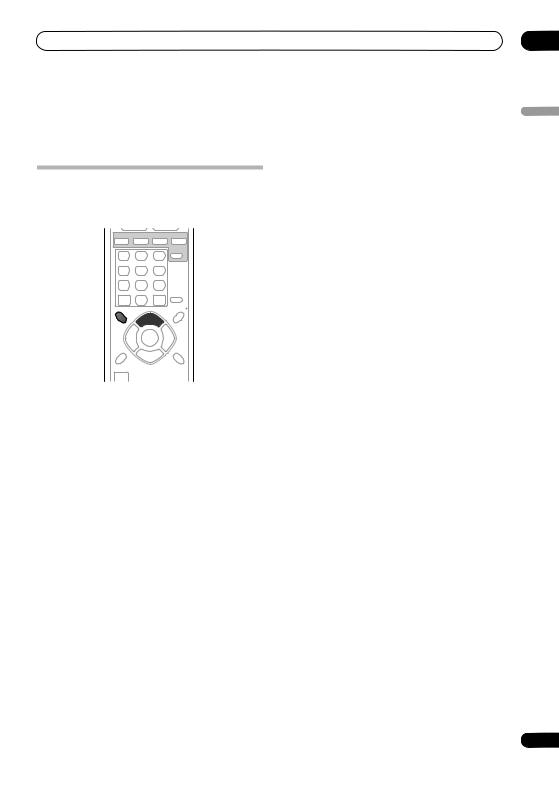
Listening to the radio
Chapter 6
Listening to the radio
Listening to the radio
The tuner can receive both FM and AM broadcasts, and lets you memorize your favorite stations so you don’t have to manually tune in every time you want to listen.
DVD/DVR1 DVD/DVR2 DIGITAL ANALOG
|
FM/AM |
|
SLEEP |
ENTER |
CLEAR |
SETUP |
SR |
|
TUNE |
ST |
ST |
|
ENTER |
SOUND |
TEST |
TONE |
|
|
TUNE |
SOUND |
|
RETRIEVER |
|
3 Use the /(cursor up/down) buttons to select FM
MONO then press ENTER.
The mono indicator ( ) lights when the tuner is in mono reception mode.
) lights when the tuner is in mono reception mode.
Select FM AUTO above to switch back to auto-stereo mode (the stereo indicator ( ) lights when receiving a stereo broadcast).
) lights when receiving a stereo broadcast).
Improving poor AM sound
The simplest way to improve the sound quality of AM radio is to make sure that the TV in the room is switched off. Also try changing the position and direction of the AM loop antenna.
Changing the noise cut mode
If you find that the sound quality is bad even after trying the above, you may be able to improve it using a different noise cut mode. Just choose the one that sounds best.
1Press FM/AM to switch to the tuner, then press repeatedly to select the FM or AM band.
The display shows the band and frequency.
2Tune to a frequency.
There are three tuning modes — manual, auto, and highspeed:
•Manual tuning – Press TUNE +/– repeatedly to change the displayed frequency.
•Auto tuning – Press and hold TUNE +/– until the frequency display starts to move, then release. The tuner will stop on the next station it finds. Repeat to keep searching.
•High-speed tuning – Press and hold TUNE +/– until the frequency display starts to move rapidly. Keep the button held down until you reach the frequency you want. If necessary, fine tune the frequency using the manual tuning method.
Improving poor FM reception
If you’re listening to an FM station in stereo but the reception is weak, you can improve the sound quality by switching to mono.
1Tune to an FM radio station then press SETUP.
2Use the / (cursor left/right) buttons to choose
FM MODE then press ENTER.
1Tune to an AM radio station then press SETUP.
2Use the / (cursor left/right) buttons to choose
NOISECUT then press ENTER.
3Use the / (cursor up/down) buttons to select a
Noise cut mode (1, 2 or 3) then press ENTER.
Memorizing stations
You can save up to 30 station presets so that you always have easy access to your favorite stations without having to tune in manually each time.
1 Tune to an FM or AM radio station.
Select mono or auto-stereo reception (FM) or the Noise Cut mode (AM) as necessary. These settings are saved along with the preset.
2Press SETUP.
3Use the / (cursor left/right) buttons to choose
ST.MEM. then press ENTER.
4Use the /(cursor up/down) buttons to select the station preset you want then press ENTER.
Listening to station presets
1Make sure the tuner function is selected.
2Use the ST +/– buttons to select a station preset.
•Alternatively, use the number buttons to select a preset directly.
06
English
19
En
